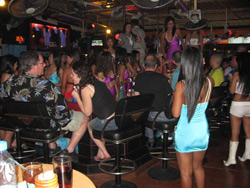
The sex industry sets its sites on the Northland Hill-Tribe villages to buy, trick or kidnap their Daughters who are usually very young (no more then 7 years old). They traffic them all over the world. To 'season' the children, they put them alone in a locked room with no windows for two years, serving 10 to12 customers a day. The men do not wear condoms because the competition is too great between the brothels. They will eventually get HIV and are beaten if they protest. After 2 years they are allowed to work along side other sex slaves in the brothels and are watched very carefully. It is very dangerous to rescue them.
Abba House Foundation is A SAFE HOME for the Pre and Post Sex Slave Children of Thailand.
Trafficking:“Trafficking in human beings is now the third-largest money making venture in the world, after illegal weapons and drugs. In fact, the United Nations estimates that the trade nets organized crime more than $12 billion a year” (Victor Malarek The Natashas: Inside the New Global Sex Trade).According to a CIA report, 700,000 to 2 million women and children worldwide are victimized by traffickers each year. The UN estimates that around 4 million people a year are now traded against their will to work in some form of slavery. As many as 50,000 women and children from Asia, Latin America, and Eastern Europe are brought to the U.S. under false pretenses each year and forced to work as prostitutes, abused laborers or servants (Joel Brinkley NYT citing CIA report).
Human Trafficking!
Thailand facts:
Profits from prositution are around three times higher then the drug trade. (Pasuk Phongpaichit estimates, he is a specialist on the economics of the Thai industry)
74 Million women are missing in Southern Asia. Note: The population of CA is 36.6M (Louise Brown’s book, Sex slaves the trafficking of women in Asia). (Oxford University Press, 1997)
2.8M Sex workers in Thailand
2M women, 20,000 adult males, 800,000 minors
Sex Tourism equals $4.3B U.S. dollars a year, 3% of the Thai economy.
Note the above 3 facts are by; Dr. Nitet Tinnakul from Chulalong University at http://www.answers.com/topic/prostitution-in-thailand

IAST- Initiative Against Sexual Trafficking
c/o The Salvation Army USA
National Headquarters
Request from: Sign up for a regular update on trafficking by e-mail or to receive the IAST Report dedicated to discussion of news and issues regarding sexual trafficking and commercial exploitation.
Rescue and Restore victims of Human Trafficking: www.acf.hhs.gov/trafficking/index.html
This site offers tool kits for those in health, social and law enforcement to identity, understand, communicate with and seek help for victims of trafficking.
http://www.iast.net/
Also see,
Bound to the sex trade: Bangkok's red-light districts
Farley, Melissa, PhD and Howard Barkan, Dr PH. “Prostitution, Violence, and
Posttraumatic Stress Disorder.” Women and Health Vol. 27(3) (1998): 37-49.
Farley, Melissa, Isin Baral, Merab Kiremire and Ufuk Sezgin. “Prostitution in Five Countries: Violence and Post-Traumatic Stress Disorder.” Feminism & Psychology Vol. 8(4) (1998): 405-426.
Hughes, Donna. “Would Legalizing Prostitution Curb the Trafficking of Women? No: Legalization Would Legitimize Abuse.” Transitions – Changes in Post-Communist Societies Vol. 5:1 (January 1998) Available at www.uri.edu
Westwood, David. “Child Trafficking in Asia.” Child Rights & The UK: Promoting the Convention on the Rights of the Child World-Wide (World Vision Briefing Paper No. 4 November 1998).
Wynter, Sarah. “WHISPER: Women Hurt in Systems of Prostitution Engaged in Revolt,” July 1986.
Adams, Carol J. Violence Against Women and Children: A Christian Theological Sourcebook. New York:Continuum, 1998.
Bales, Kevin. Disposable People: New Slavery in the Global Economy.
Berkeley:University of California Press, 1999.
Brock, Rita Nakashima and Susan Brooks Thistlewaite. Casting Stones:Prostitution and Liberation in Asia and the United States. Minneapolis:Fortress Press, 1996.
D’Cunha, Jean. The Legalization of Prostitution. Bangalore: Wordmakers, 1991.
Farley (Ed.), Melissa. Prostitution, trafficking and traumatic stress. (2003). New York: The Haworth Press.
Kilbourn, Phyllis, and Marjorie McDermid, ed. Sexually Exploited Children: Working to Protect and Heal. Monrovia: MARC, 1998.
Malarek,Victor “The Natashas: Inside the New Global Sex Trade”
Fact book on Thailand - Sex Slave Exploition
www.uri.edu/artsci/wms/hughes/thailand.htm